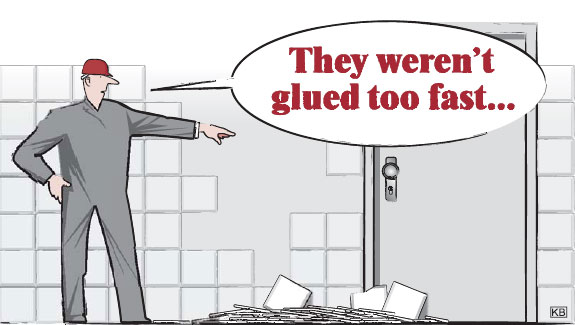Ceramic tiles are widely used in the construction industry as both fl oor and wall coverings. Owing to their properties, ceramic tiles serve both as an aesthetic design component and a practical finishing building material. Over the years, ceramic tiles have become and indispensable feature of houses, spas and sports facilities.

Płytki ceramiczne są szeroko stosowane w przemyśle budowlanym przy pokrywaniu ścian i podłóg. Dzięki swoim właściwościom, pełnią one zarówno funkcje estetyczne jako element dekoracyjny, jak również są praktycznym materiałem budowlanym. Na przestrzeni lat płytki stały się nieodłącznym elementem domów i obiektów sportowo-rekreacyjnych.
1. W których miejscach w tekście poniżej powinny znaleźć się następujące zwroty?
a) as long as it can support their weighto ile jest w stanie utrzymać ich ciężar
b) maintain equal spacingzachować równe odstępy
c) once all of the tiles are cemented to the areagdy już wszystkie płytki są przymocowane
d) relatively low resistance to shock and damagestosunkowo mała odporność na wstrząsy i uszkodzenia
e) the anticipated traffic and soilingprzewidywana częstotliwość używania i stopień zabrudzenia
f) the layout should be planned beforehandrozmieszczenie powinno być zaplanowane wcześniej
g) tile surface abrasion resistanceodporność powierzchni płytki na ścieranie
h) to receive ceramic tilesmające (które mają) być pokryte płytkami
Ceramic tiles
Ceramic tiles are manufactured from a mixture of clay, sand and other naturally occurring materials, formed into slabs and fi red at high temperatures. The characteristic features of all ceramic materials are durability, non-combustibility, fire-resistance and easy maintenance. However, tiles are also rigid and have ………………..Odpowiedź: d When considering the choice of ceramic tiles, it is vital first to understand their properties. Depending on the type (glazed, unglazed, quarry, porcelain), ceramic tiles can be waterproof or porous, stain and slip resistant, and come in a variety of colours and tones. Moreover, each manufacturer indicates ………………..Odpowiedź: e, recommending in which areas tiles can be installed, depending on ………………..Odpowiedź: g.
Ground preparation
Ceramic tiles can be installed on almost any type of wall, ………………..Odpowiedź: a, whereas the sub-floor should be sound, rigid and flat – otherwise, it will be necessary to stabilize it and install a plywood or masonry underlay. As all surfaces ………………..Odpowiedź: h must be free of paint, grease, and dust, it may be necessary to lightly sand the surface to remove any excess paint or other material.
Installation
There are many methods of laying out ceramic floor tiles. ………………..Odpowiedź: f in order to avoid a lot of cutting and to ………………..Odpowiedź: b.
To set most ceramic tiles, thin set or mastic are used. The thin set must be mixed by adding water and stirring to achieve the proper, rather thick consistency. Once the thin set is mixed, it is trowelled over the area where the tile will be set, within the arm’s reach of the tiler. The tiler then presses the tiles or sheets of tiles into place, using a level or inserting spacers on each corner of the tile joints. Floor tiles should be set about 24 hours before grouting.
Grouting
………………..Odpowiedź: c, grout is applied. It has to be carefully mixed to the proper consistency, in order to remove lumps and avoid creating air bubbles. The tiler spreads the grout over the tile joints, then cleans the excess away with a damp sponge. Tile joints along walls, bathtubs, sinks, etc. are filled with silicon-based caulk.
{mospagebreak}
2. Przetłumacz poniższe zdania. Użyj wymienionych poniżej czasowników.
indicates, remove, avoid, achieve, inserting, applied
a) Następujące pomiary mogą wskazywać na problemy z korozją.The following measurments can indicate potential corrosion problems
b) Cegły muszą schnąć równo, aby uniknąć pęknięć.Bricks must dry evenly to avoid cracking
c) Pracuj powoli i zachowuj rozsądne proporcje aby osiągnąć jak najlepsze rezultaty.Work slowly and maintain reasonable proportions to achieve best results
d) W trakcie upału lakier nie powinien być stosowany przy bezpośrednim nasłonecznieniu (direct sunlight).During hot weather lacquer shouldn’t be applied in direct sunlight
e) Luka między panelami zezwala na wstawienie przewodów elektrycznych.The gap between the panels allows you to insert electrical wiring
f) Będzie bardzo trudno usunąć beton, gdy już wyschnie.It will be very difficult to remove concrete once it dries
3. Dopasuj następujące narzędzia i materiały do podanych poniżej sposobów ich wykorzystania.
tile sawmaszyna do cięcia płytek, levelpoziomica, thin setkrzyżyki dystansowe, notched trowelpaca zębata, groutfuga, caulkuszczelniać, spacersrozpórki, grout floatgumowa packa do fugowania, nippersszczypce do cięcia płytek
1. ……….tile saw cuts tiles leaving a clean, smooth edge.
2. ……….caulk is a substance used to fill holes, cracks, joints in order to make a surface watertight.
3. ……….grout float is a rubber-faced tool used to apply grout to tiles.
4. ……….grout is a material used to fill joints between the tiles.
5. ……….level is an instrument for checking whether a surface is horizontal, vertical, or at a 45° angle.
6. ……….nippers work by removing small bits of tile at a time and are used to cut small curves and unusual shapes to fi t tile into tight areas.
7. ……….notched trowel is a tool used to spread thinsets on horizontal surfaces.
8. ……….thin set is an adhesive material used for tile setting.
9. Tile ……….spacers are small pieces of plastic used to maintain consistent width of the grout joints.
Grammar – zdania warunkowe (conditional sentences).
Zdanie warunkowe, jak sama nazwa wskazuje, odnoszą się do sytuacji, które pojawiają się, gdy zaistnieją ku temu określone warunki. Jedna część zdania zawiera często słowo if (jeżeli, gdyby) i przedstawia warunek, natomiast druga część zdania opisuje następstwa spełnienia tego warunku.
Zdania warunkowe typu „0” odnoszą się do zjawisk stale występujących (działań rutynowych, ogólnych prawd, praw fizycznych, faktów naukowych), mających ten sam rezultat, przy spełnieniu określonych warunków. W obydwu częściach zdania używamy wówczas czasu present simple.
If you throw a stone into the water, it sinks.
Jeżeli wrzucasz kamień do wody, on tonie.
If you mix cement with with water and sand, you get mortar.
Jeśli wymieszasz cement z wodą i piaskiem, otrzymasz zaprawę murarską.
Zdania warunkowe typu I odnoszą się do warunków możliwych do spełnienia w przyszłości. Używamy wówczas konstrukcji if/ unless (chyba, że) + present simple // will + bezokolicznik. Identyczną budowę mają zdania czasowe, w których w miejsce if występują inne spójniki, np: when (kiedy), as soon as (jak tylko).
If she comes here, I’ll give her the message.
Jeśli przyjdzie, przekażę jej wiadomość.
Materials will perform well, if you use them as directed.
Materiały będą spełniały swoją funkcję, jeżeli zastosujesz je wg wskazówek.
Study tip!
Wskazówką, którą warto zastosować ucząc się języka obcego, jest wykorzystywanie wyobraźni przy rozwijaniu sprawności mówienia. Należy wyobrazić sobie zatem sytuacje, w których rozmawiamy z nauczycielem, turystą czy znajomym obcokrajowcem i chcemy opowiedzieć im o interesującym zdarzeniu, przekonać do naszego pomysłu, udzielić wskazówki, itp. Przygotowujemy lub przypominamy sobie wtedy słowa i wyrażenia, których możemy użyć, następnie całą wypowiedź kilkakrotnie powtarzamy głośno lub w myśli. Prawdopodobnie wielu z tych opowieści nikomu nie przedstawimy, lecz ćwiczenie to poprawi płynność wypowiedzi oraz pomoże przełamać tremę i blokadę psychiczną przy porozumiewaniu się w obcym języku. Doda nam również wiary we własne umiejętności i zwiększy motywację do nauki.

Aneta Kaproń
Artykuł zamieszczony
w „Inżynierze budownictwa”,
maj 2007.





